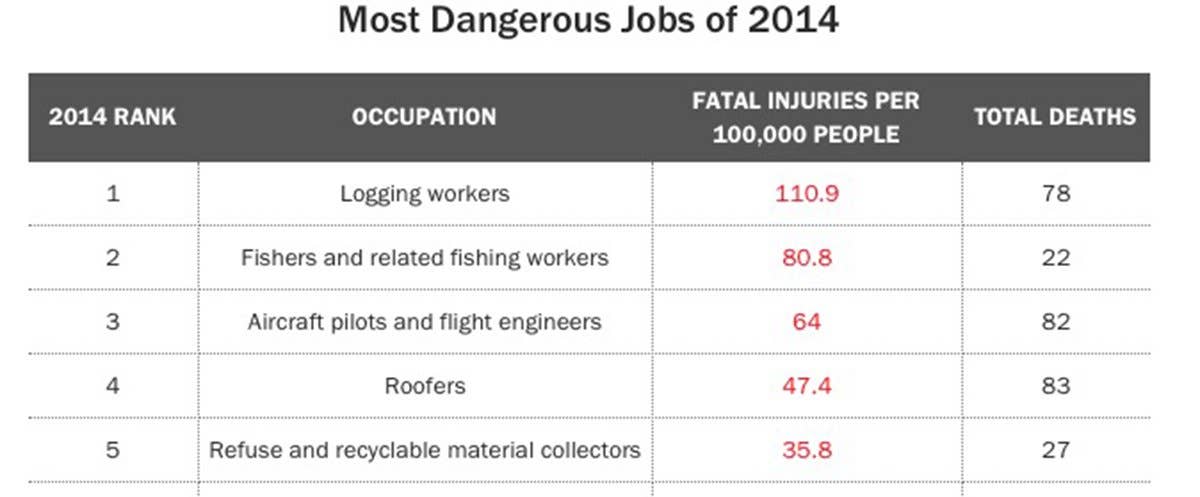Commercial Piloting: Quite A Risky Profession
Or so the U.S. census tracking of fatal job injuries would have us believe. But is that a fair assessment?

The other day, I was driving down a Florida road and had to slow for a power company crew repairing a live line—a big one, one of those kilovolt distribution jobs. It was raining lightly and there was lightning in the distance. "No way in hell I'd ever do that job," I thought to myself.
Yet, I now learn that being a commercial pilot is four times more dangerous than being a lineman and is, in fact, the third most dangerous job in the U.S., right behind loggers and commercial fisher people. Huh? In aviation, we reflexively know that riding on a commercial aircraft is the safest form of transportation available. How is it that the pilots flying these very same airplanes are dropping like flies?
It's complicated and even at that, I challenge the data and the conclusions. I picked up the story while skimming Time, whichhad a short piece on the most dangerous jobs in America. If the unsuspecting would-be commercial aviator saw that table without a deeper understanding of the reality, he or she might elect to go into cake decorating or beekeeping instead.
If you click through the links, you'll discover that the data was developed by the Census of Fatal Occupational Injuries.I phoned the census agency to get a sense of how this data is collected, but the answer is, by aviation accident investigation standards, rather murky. The source data trickles in through something called the Current Population Survey and as the linked document explains, this has been used in two ways—one is risk based on hours data and other is employment data, in other words death per 100,000 workers engaged in the occupation being examined.
Here's where the disconnect occurs, I think. Risk assessment is based on numerators and denominators, with the former being the actual occurrence of accidents and the latter being the exposure basis, say hours flown or number of pilots exposed. Either way of looking at it is legitimate, as long as the comparisons are consistent.
The first easy—albeit tedious—back check of the census table is to look at the fatal accidents in which commercial pilots died. The table lists 82 in 2014. Well, scratch off any pilots involved in Part 121 flying. There were exactly zero that year. Digging further to find those 82 deaths reveals a matrix of flight instruction, sightseeing, ag flying, aeromed operations, pipeline patrol, test flying and so forth. If I cast the net as widely and generously—and, frankly, as sloppily—as possible, I come up with about 78 deaths. That's pretty close to the 82 and within a reasonable error margin.
Unfortunately, what appears to have happened here is that any commercial pilot involved in an accident was listed … as a commercial pilot death. So that means the commercial pilot flying a personal trip from Ohio to Virginia was probably listed as a commercial pilot death when he crashed, as was the commercial pilot who died on a post-maintenance flight after working on his personal airplane. In other words, if you have commercial pilot on your certificate, the data appears to be blind as to whether you were flying personally or for pay.
If I extract all of those clearly non-commercial operations, I can only find about 55 deaths, even if I use supremely loose definitions of commercial flying. And because of imprecision on the records, some of those may be dupes. That alone drives the risk index further down the chart.
The census data quotes the risk data in deaths per 100,000 participants, a method that requires knowing how many participants—pilots—there actually are. This is tricky because the FAA listed a total of 104,322 commercial pilots and another 152,933 ATPs for 2014. Obviously, only a portion of those are active for-hire pilots, but what's the real number? The census calculates this through a formula based on a survey of hours worked and my guess is that it arrives at a number that's too low.
The Bureau of Labor Statistics—yet another agency running by its own rules—uses a figure of about119,000 commercial pilots of all kinds. Kit Darby's airline recruiting site quotes about 90,000 pilots for scheduled carriers and if that's accurate, there are about 30,000 for-hire professional pilots doing flight instruction, pipeline patrol, ag flying and dozens of other non-Part 121 jobs. This seems realistic to me, although it could be higher. If I use it as the denominator but with my own estimate of actual commercial accidents, the job-related fatal risk of being a pilot is about the same as being a roofer. But if I apply a more stringent guideline for what constitutes a commercial pilot death, the risk drops another notch or two.
But does any of this matter? Perhaps only to a data nerd like me, obsessed as I am with judging risk by actual accident and exposure data, not just by perceptions of what's "dangerous." Whether the census data is accurate or not—and I don't think it is—there are a couple of takeaways that won't be obvious from the data. The unschooled reader might read "commercial pilot" as airline pilot. This is wrong, obviously. If you're a Part 121 pilot, you have pretty close to a functionally zero chance of dying on the job in a crash. Heart attack, maybe, or falling off the jetway, but not a crash.
Second, "commercial pilot" in this context really means general aviation and mostly Part 91 general aviation. Even if we could squeeze all the error out of the data, I suspect pilots would still finish in the top 10 of the most dangerous jobs. That's really not very good and is a mild indictment of the industry's difficulty in driving the fatal accident rate lower than it is now, even though it has been trending downward for years, flattening during the past decade.
The big picture takeaway, however, is this: Most of those fatal accidents are due to human carelessness and avoidable error. Thanks to stringent Part 121 regulation and ever more reliable aircraft, airline flying has greatly diminished the impact of such human frailties, although what accidents that do occur are often human error. No such net exists for Part 91 commercial flying. Part 135 is certainly better, but not quite up to Part 121 standards. Even in those operations where pilots are getting paid, the GA side of the industry still allows us to blunder around of our own free will and dot the landscape with charred craters. I suppose if you know this, you are better equipped to own your own decision-making and act accordingly in your own best interest. If that won't do, there appear to be some openings in the logging industry.
Happy Birthday John Glenn
I noticed that Time's Jeffrey Kluger has a nice tribute to Mercury astronaut John Glenn, who turns 95 today. And what an eventful life he has lived, from World War II and Korea fighter pilot, to test pilot, to astronaut, to Senator and back to astronaut. At 77, he was NASA's oldest mission specialist and distinguished himself as much on his last space flight as his first.
Glenn is both timeless and a hero for another age. He is the last of original Mercury 7 astronauts and arguably the most well known. Alan Shepard would be a close second. But I remember the day that Glenn returned from orbit as clearly as though it was yesterday. I suspect a lot of us do and certainly more than enough to wish him a happy birthday.






